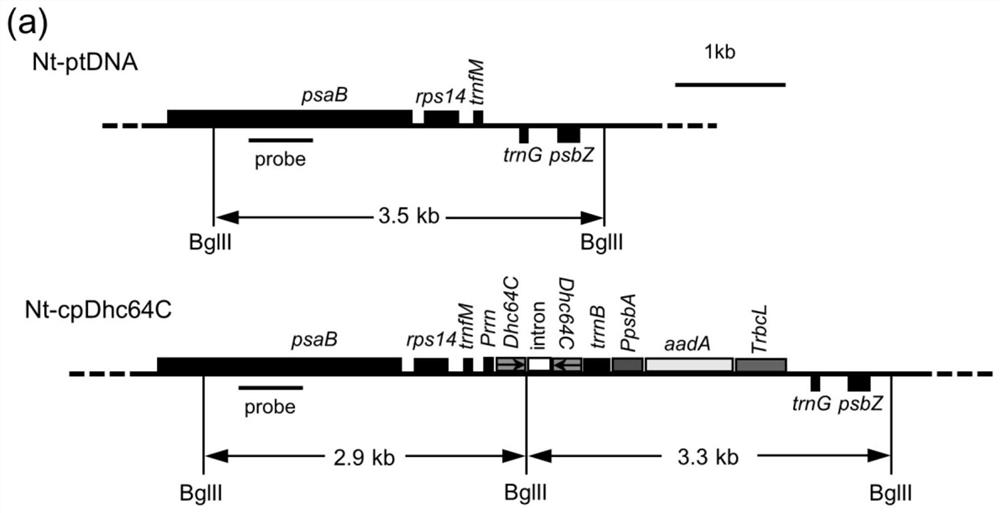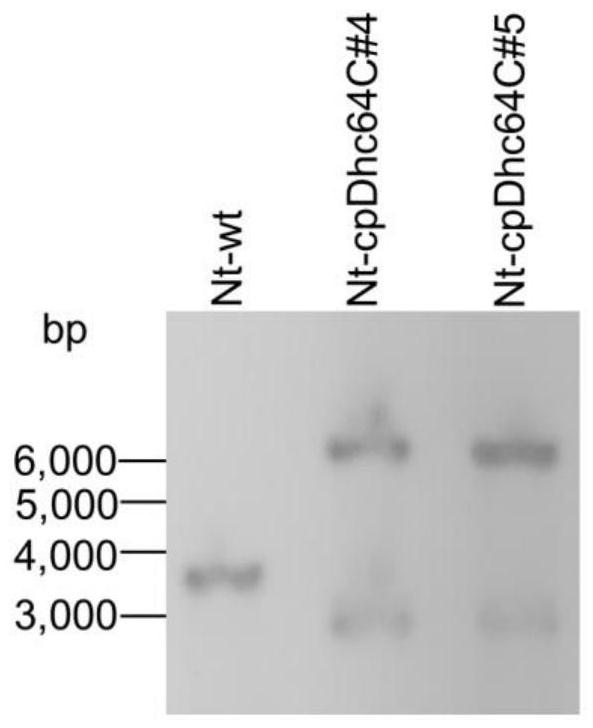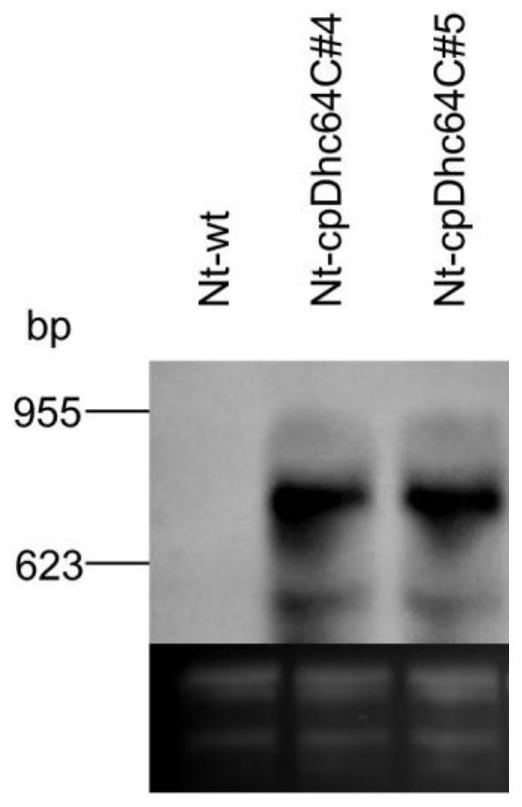Preparation method of plastid transgenic plant for preventing and treating Myzus persicae (Sulzer), and application of plastid transgenic plant in prevention and treatment of Myzus persicae (Sulzer)
A technology of transgenic plants, Myzus persicae, applied in the field of biology
- Summary
- Abstract
- Description
- Claims
- Application Information
AI Technical Summary
Problems solved by technology
Method used
Image
Examples
Embodiment 1
[0035] The acquisition of embodiment 1 Dhc64C gene
[0036] 1. Green peach aphids are raised in an artificial environment at 25±1°C, 75-80% relative humidity, and 16L:10D photoperiod. The cDNA sequence of the green peach aphid Dhc64C gene used for dsRNA synthesis is shown in SEQ ID NO: 1; the CDS interval sequence of the green peach aphid Dhc64C gene is shown in SEQ ID NO: 2.
[0037] The sequence of specific primers for Dhc64C gene of green peach aphid is as follows:
[0038] Upstream primer F: 5'-CTCATGTAATTGATCCAAAAGCCAT-3', SEQ ID NO.3;
[0039] Downstream primer R: 5'-TCGAACATTGGGTGGAAGAGAT-3', SEQ ID NO.4.
[0040] 2. The total RNA of peach aphid was extracted with RNAiso Plus reagent from Takara Company.
[0041] 3. Reverse transcription reaction
[0042] Residual Genomic DNA Removal
[0043] Prepare the following mixture in an RNase free centrifuge tube, mix well by microcentrifugation, and incubate at 42°C for 2 minutes.
[0044]
[0045] Reverse transcriptio...
Embodiment 2
[0063] The construction of embodiment 2 plant expression vectors
[0064] 1. pUC-Dhc64C 1st intermediate vector construction
[0065] 1.1 Double digestion of vector fragments
[0066] The pUC-RNAi intermediate vector was used to introduce the intron structure. pUC-RNAi is the previous scientific research achievement of our laboratory, which was published in the article Full crop protection from an insect pest by expression of long double-stranded RNAs in plastids in the journal Science in 2015. Dhc64C-1 st The (XhoI / BglII) fragment and the intermediate vector pUC-RNAi vector were subjected to XhoI / BglII double enzyme digestion, and the reaction was carried out for 3 hours. The system was as follows:
[0067]
[0068] Carry out sample loading and electrophoresis for the enzyme digestion system of the intermediate carrier, observe the target bands in the UV gel imaging system, and perform gel recovery of the target fragments, the method is the same as above. Perform solu...
Embodiment 3
[0100] The preparation of the plant of embodiment 3 plastid transformation
[0101] 1. Plant material preparation:
[0102] Tobacco seeds were cultivated in a sterile environment, temperature: 25°C / 20°C, photoperiod: 16h light / 8h dark, light intensity: 25μE. When the plant reaches 1 / 2 to 1 / 3 of the height of the bottle, take 2-4 pieces of the youngest leaves and spread them on RMOP (antibiotic-free) plastic plates with the stomata facing up (the plates should be thinner and contain about 30 mL of culture) base).
[0103] 2. Preparation for gene gun bombardment: the main steps are:
[0104] 1) Turn on the vacuum pump of the particle gun half an hour before use (adjust the air pressure to 1350psi);
[0105] 2) Sterilized large glass plate; absolute ethanol; each gun: 1 cleavable membrane (1100psi) and 7 micro slides; 1 blocking net for each plasmid;
[0106] 3) Wash the splittable membrane (less than 1 min), micro slide (5 min), blocking net and gene gun parts (5 min) with a...
PUM
 Login to View More
Login to View More Abstract
Description
Claims
Application Information
 Login to View More
Login to View More - R&D
- Intellectual Property
- Life Sciences
- Materials
- Tech Scout
- Unparalleled Data Quality
- Higher Quality Content
- 60% Fewer Hallucinations
Browse by: Latest US Patents, China's latest patents, Technical Efficacy Thesaurus, Application Domain, Technology Topic, Popular Technical Reports.
© 2025 PatSnap. All rights reserved.Legal|Privacy policy|Modern Slavery Act Transparency Statement|Sitemap|About US| Contact US: help@patsnap.com



